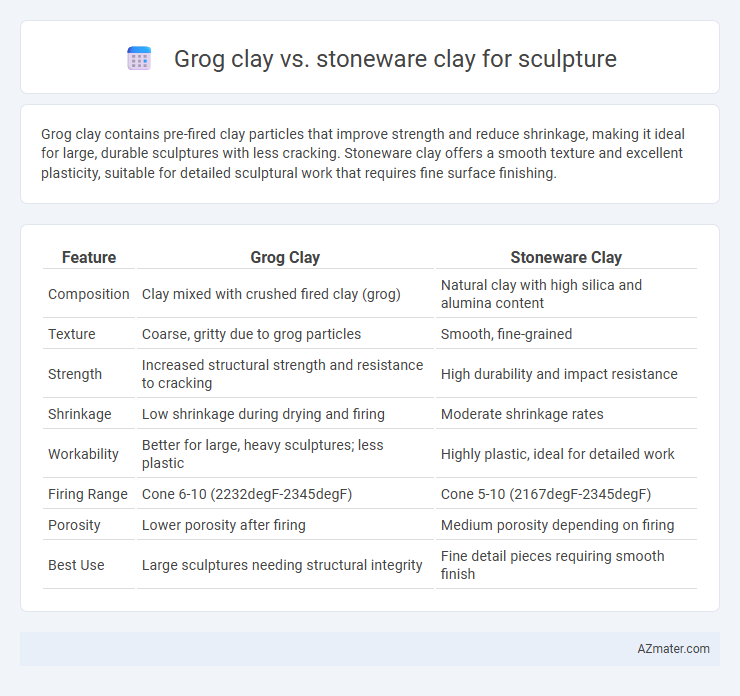Grog clay contains pre-fired clay particles that improve strength and reduce shrinkage, making it ideal for large, durable sculptures with less cracking. Stoneware clay offers a smooth texture and excellent plasticity, suitable for detailed sculptural work that requires fine surface finishing.
Table of Comparison
| Feature | Grog Clay | Stoneware Clay |
|---|---|---|
| Composition | Clay mixed with crushed fired clay (grog) | Natural clay with high silica and alumina content |
| Texture | Coarse, gritty due to grog particles | Smooth, fine-grained |
| Strength | Increased structural strength and resistance to cracking | High durability and impact resistance |
| Shrinkage | Low shrinkage during drying and firing | Moderate shrinkage rates |
| Workability | Better for large, heavy sculptures; less plastic | Highly plastic, ideal for detailed work |
| Firing Range | Cone 6-10 (2232degF-2345degF) | Cone 5-10 (2167degF-2345degF) |
| Porosity | Lower porosity after firing | Medium porosity depending on firing |
| Best Use | Large sculptures needing structural integrity | Fine detail pieces requiring smooth finish |
Understanding Grog Clay: Composition and Properties
Grog clay contains pre-fired clay particles, known as grog, which enhance its thermal shock resistance and reduce shrinkage during drying and firing, making it ideal for sculptural applications requiring durability. The coarse texture of grog improves the clay's workability and prevents cracking in larger or intricate sculptures by providing internal support. Stoneware clay, while also durable and suitable for sculpture, lacks the coarse grog particles, resulting in smoother surfaces but potentially higher shrinkage and less resistance to thermal stress compared to grog clay.
What is Stoneware Clay? Key Characteristics
Stoneware clay is a durable, versatile ceramic material known for its high firing temperature between 1,200degC and 1,300degC, resulting in a vitrified, non-porous surface ideal for functional and sculptural pieces. Its plasticity offers ease of shaping while maintaining strength and resistance to chipping, making it suitable for detailed sculptures requiring structural stability. Compared to grog clay, which contains pre-fired clay particles for added texture and reduced shrinkage, stoneware clay provides a smoother finish and greater density, enhancing the final artwork's durability and aesthetic appeal.
Workability: Sculpting with Grog Clay vs Stoneware Clay
Grog clay contains pre-fired clay particles that enhance texture and reduce shrinkage, making it highly suitable for sculpting detailed, sturdy pieces with less cracking risk. Stoneware clay, known for its smooth and plastic consistency, offers easier manipulation and finer surface finishes but may require careful handling to prevent warping during drying. Choosing between grog and stoneware clay depends on the desired texture, durability, and handling preferences in sculpture projects.
Texture and Surface Finish Differences
Grog clay contains pre-fired and ground ceramic particles that create a rougher texture, enhancing structural support and reducing shrinkage, making it ideal for detailed sculptural work requiring strong texture. Stoneware clay offers a smoother texture and produces a denser, more refined surface finish that is well-suited for sculptures demanding a polished or sleek appearance. The choice between grog and stoneware clay directly impacts the tactile quality, drying behavior, and final aesthetic of the sculpture's surface.
Strength and Durability: Comparing the Final Sculptures
Grog clay enhances sculpture strength and durability by incorporating ground fired clay particles that reduce shrinkage and cracking during drying and firing, resulting in a more robust final piece. Stoneware clay is naturally dense and vitrifies at high temperatures, producing strong, durable sculptures with excellent resistance to chipping and water absorption. Sculptors seeking maximum resilience often choose grog clay for its structural support, while stoneware clay balances toughness with a smoother surface finish.
Firing Temperatures and Kiln Performance
Grog clay contains pre-fired clay particles that improve thermal shock resistance and reduce shrinkage during firing, making it ideal for high-temperature stoneware firings typically between 1200degC and 1300degC. Stoneware clay vitrifies at high temperatures, producing dense, durable ceramics suited for kiln environments reaching cone 6-10 (approximately 1200degC-1300degC). The inclusion of grog enhances kiln performance by minimizing warping and cracking, thus optimizing sculptural stability throughout the firing process.
Color Variations: Grog Clay vs Stoneware Clay
Grog clay offers a range of earthy, natural tones due to its inclusion of fired clay particles, enhancing texture and color depth in sculptures. Stoneware clay typically presents more uniform color variations, often in muted grays and browns, allowing for consistent finishes and glazing effects. Artists choose grog clay for rustic aesthetics and stoneware clay for smooth, refined surfaces in sculptural works.
Best Uses: When to Choose Grog or Stoneware for Sculpture
Grog clay, with its coarse texture and added fired particles, is ideal for large-scale sculptures requiring increased strength, reduced shrinkage, and enhanced structural support during firing. Stoneware clay offers a smoother finish and greater plasticity, making it suitable for detailed, delicate sculptures that demand fine surface work and a durable, vitrified final piece. Choose grog clay to prevent cracking in bulky forms; select stoneware clay for refined shapes where a high-quality surface and durability are priorities.
Cost Comparison and Availability
Grog clay typically offers a budget-friendly option for sculptors due to its coarse, pre-ground inclusions that reduce shrinkage and warping, making it cost-effective for large projects. Stoneware clay, while often more expensive than grog clay, provides a smoother texture and greater availability in various formulations across art supply stores. Availability may vary regionally, but grog clay is usually more specialized and less widely stocked compared to the widely accessible stoneware clay favored for its durability and finishing qualities.
Tips for Sculptors: Selecting the Ideal Clay for Your Project
Grog clay, enriched with pre-fired clay particles, enhances texture and reduces shrinkage, making it ideal for large sculptures requiring strength and durability. Stoneware clay offers a smooth surface and excellent plasticity, perfect for detailed work and fine finishing in both functional and artistic pieces. Sculptors should consider the clay's grog content for stability and workability when selecting the ideal medium for structural integrity and surface detail.

Infographic: Grog clay vs Stoneware clay for Sculpture
 azmater.com
azmater.com